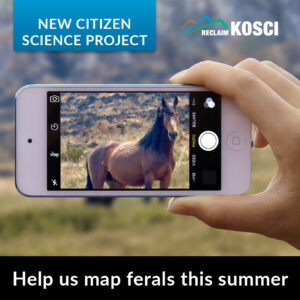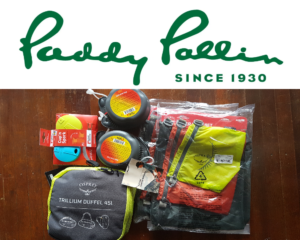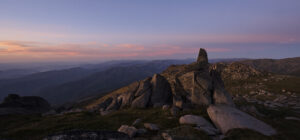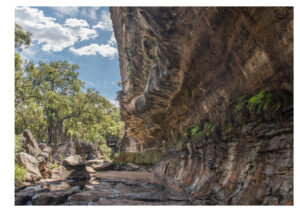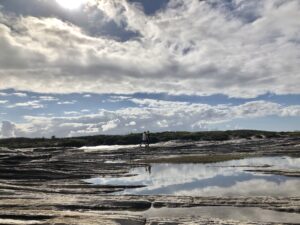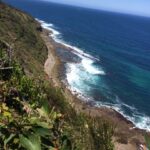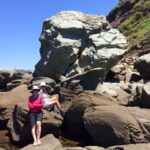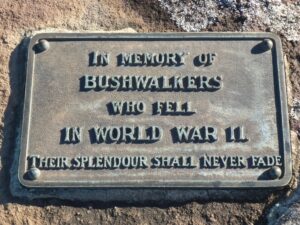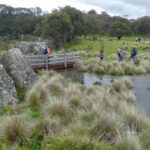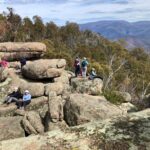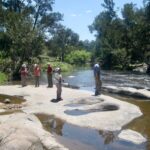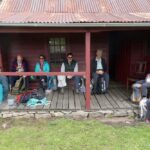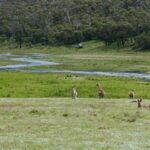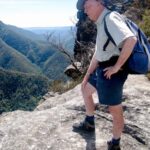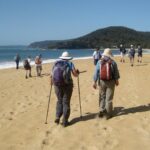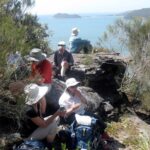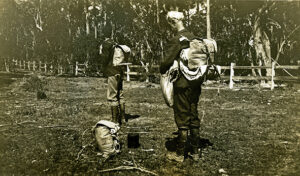This year Sutherland Bushwalkers celebrates its 50th anniversary and has published a commemorative pictorial club history to celebrate the milestone.
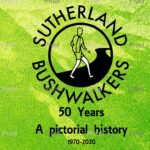
The new 50th anniversary book cover
It would be difficult to determine when the club commenced, as it started with a very informal gathering of like-minded people. Most of them worked at the Atomic Energy Commission at Lucas Heights or were connected with various Scouting and Rover groups in Sutherland Shire. The first activity of the group was a bushwalk from Yadboro up the Kalianna Ridge into the Monolith Valley and to Mount Owen on the Australia Day weekend, in January 1969.
In these very early stages it was an all-male association simply because of the common AAEC and Scouting link, but it didn’t take too long before a few more friends and wives were attending the activities.
Activities in the late sixties were arranged very casually when one of the group would write a brief description of an outing and then send it to all the others. Early activities included caving at Colong and Tuglow, walking the Budawangs, the Blueys and Kanangra, canoeing the Kangaroo and Shoalhaven. About two-thirds of the group had reasonably good bushwalking experience but there were virtually no caving, canoeing or other bushsports skills. Even so, this provided a good basis for real adventure and enjoyment of the bush.
By mid-1969 the group had expanded to about thirteen ‘members’ and some felt that a title would be appropriate. One name, ‘The Intrepids’ was considered to be a little irrelevant. About May 1970 the group chose the name ‘Sydney Bush Ramblers’. However, by the end of 1969 the casual group was still without any formal structure, club officers or regular meetings.
With the numbers gradually increasing to twenty-one by March 1970, a sketchy program of eighteen activities was compiled for that year.
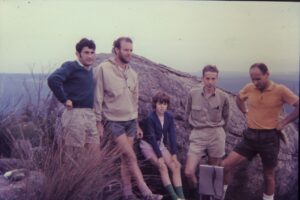
1970s Some of the founding members: Maurie Bloom at left is still a club member, Jim Stevens, Kim Rice, Graeme Carter, Don Rice
During 1970, membership increased slowly through friends and personal contacts and by August there were about twenty-eight on the club list. During one bushwalk, the group met some members of the Catholic Bushwalkers who suggested that they should consider affiliating with the Bushwalkers Federation (forerunner of Bushwalking NSW). Little was known of the organisation, so they send a delegation to a Federation meeting to learn a bit more about their requirements for affiliation.
As a result, the first club general meeting of thirteen people was arranged in September 1970 to discuss this issue and to decide if it was worth joining. It was now just on two years since the original eleven decided to go bush. By the end of 1971 club membership had increased to 42 and regular meetings were held at the Caringbah Scout Hall, where they remained until a brief spell in 2006 at Kirrawee Soccer Club building, before relocating to their current home of the Stapleton Centre in Sutherland.
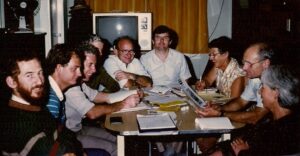
Sutherland Bushwalkers Committee Meeting, Jacaranda Scout Hall, 16 April 1984 with Murray Scott, Anthony Jackson, Graeme Carter, David Coombes, Arnold Fleischmann, Chris Terry, Beryl Young, Don Rice, Gisela Fleischmann
The club attracted many inquiries for membership during the early 1970’s but most were not interested in a club based in the Sutherland Shire and it became frustrating for the Club Committee to deal with inquiries from people who were not joining. The problem was that the Club’s name contained the word ‘Sydney’, creating confusion with the Sydney Bushwalkers Club, and also an expectation that Sydney was the club’s location. At the Annual General Meeting of February 2, 1977, the club officially became Sutherland Bushwalking Club.
Today Sutherland Bushwalkers membership holds steady at around 300 members, mostly from Sutherland Shire and the Georges River area. They conduct around 230 activities per year, attracting approximately 2,300 participants in bushwalking, cycling and kayaking in the Greater Sydney Region, around Australia and throughout the world. Bushfires and Covid-19 may have disrupted plans for anniversary celebrations, not to mention the temporary cessation of the activities program in 2020, but the club is once more enjoying friendships created through Covid-safe experiences in the bush.
